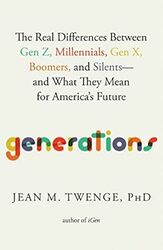
Rating: 7.7/10.
Generations: The Real Differences Between Gen Z, Millennials, Gen X, Boomers, and Silents – and What They Mean for America’s Future by Jean M. Twenge
This book examines generational differences and how values have changed over time, focusing on America. Overall, differences in generations are caused by major world events and technological advancements, which lead to varying values. In particular, more recent generations tend to have more individualistic values rather than collective; longer life expectancy has led to a slower life model, where people reach significant life milestones, such as getting a job, moving out, studying, dating, marriage, and starting a family, at a higher age.
Since generational changes affect the entire society, everyone is impacted, even if an individual is an exception among their peers – their experience will be very different from that of previous generations. Eg: a young adult today who wants to get married at age 20 and have children at age 22 would have been fairly typical in 1960 and would have followed the expected path, but the same choices today would make you an extreme outlier and you’d probably face difficulty finding a mate and gaining societal approval.
There is an issue of defining the boundaries between generations, which is arbitrary. The compromise that’s often taken when presenting statistics is showing a line chart of trends by birth instead of using arbitrary generational labels. A combination of both methods are used, although it is still useful to assign cutoff years to compare differences more easily.
The Silent Generation (born 1925-1945), was the first generation not to serve in World War II. They witnessed the rise of women working and the acceptance of interracial and gay messages. They married younger and had more children than any other generation. They tend to be politically and socially conservative, and even now, many still do not completely accept issues like homosexuality.
Baby Boomers (born 1946-1964), produced a demographic bulge as they were born during the greatest period of fertility in America, which peaked at 3.8 in 1957. They were much more individualistic than the Silent Generation and protested against the Vietnam draft, and sex before marriage was common. They were more liberal with drugs and were the last generation to experience racial segregation, while women took high-status jobs for the first time. Boomers experienced more mental health problems than the Silent Generation and deaths of despair during their elderly years, mostly due to economic factors. There is a common belief that the Boomers climbed the ladder and left Millennials behind, but in reality, many Boomers were the first to be left behind, especially those in manufacturing jobs and without college degrees, as incomes diverged for those with degrees.
Generation X (born 1965-1979), grew up in the age of computers and were more comfortable with technology than Boomers. Their childhood was in an era where loose parenting was the norm. They married in their late twenties rather than early twenties but still had a high number of children. They had more desire for material wealth than Boomers and did well economically during their working years. They had lower trust in government and authorities, were less involved in politics than the previous and next generations, and have not taken political offices as much as Boomers did at the same ages.
Millennials (born 1980-1994), have higher self-esteem than previous generations, with the majority believing that they are better than average, but they were hit with a reality check after the Great Recession. The popular myth is that Millennials are struggling financially compared to previous generations, but actually, they are doing better. They have higher incomes and higher homeownership rates compared to previous age groups, mainly driven by the rise of women’s incomes, although men’s incomes have declined slightly. They have fewer children, not due to economics but increased individualistic attitudes (although childcare has become more expensive); they are less sexually active and less religious than previous generations. Politically liberal, they create a generational divide with older generations. As young adults, they suffer more from mental health issues than previous generations due to disappointment with the reality of adult life, political polarization, and loneliness, but likely not because of economic struggles.
Generation Z, (born 1995-2012), has a much higher rate of LGBT, nonbinary, transgender, etc, especially among those born female. Life milestones like getting a driver’s license, working, and dating are being pushed to later ages. They favor restricting speech that is considered racist or offensive rather than valuing free speech like older generations. They have significantly worse mental health than previous generations, with higher rates of depression, loneliness, suicide (tech is a major contributing factor). They have negative attitudes about the future of the world and the nation, to the point where nihilism is common. Unhappiness about the direction of the country has led to higher political participation than previous generations when they were young adults.
Finally, the author tries to predict future trends that can be inferred from the attitudes of Gen Z, as they are now leaving college, starting their careers, and entering the workforce. By examining their attitudes during high school, it is possible to predict likely trends in the future. Since they value non-binary and LGBT acceptance and prioritize mental health, employers will need to adapt to these values. Decreasing interest in raising children suggest that fertility rates will continue to drop in the coming decades, leading to a shift where child-related products will be replaced by those in the pet industry, as young people increasingly choose pets over children. The market for luxury items will likely decrease because Gen Z tends to be more practical and individualistic. Certain luxuries, like vacation homes and boats, will be viewed more as extravagances rather than aspirations, although home ownership will still be desired.
Overall, the claims in this book is backed by a substantial amount of data and research. One weakness is the data is entirely focused on the American context and does not consider other countries, even those with similar trends, such as Canada or European nations, where certain trends are somewhat different. One controversial claim is that millennials are doing better economically than previous generations, which is supported by some evidence from household income, but this claim is not generally agreed upon when looking at other metrics, especially in other countries like Canada, Australia, and the UK, where income growth has not kept up with real estate prices to the extent that it has in the US. Despite this, the author repeatedly claims that economic struggles cannot be a contributing factor to various issues that young adults face, such as depression and other mental health issues, which is a highly controversial stance.



